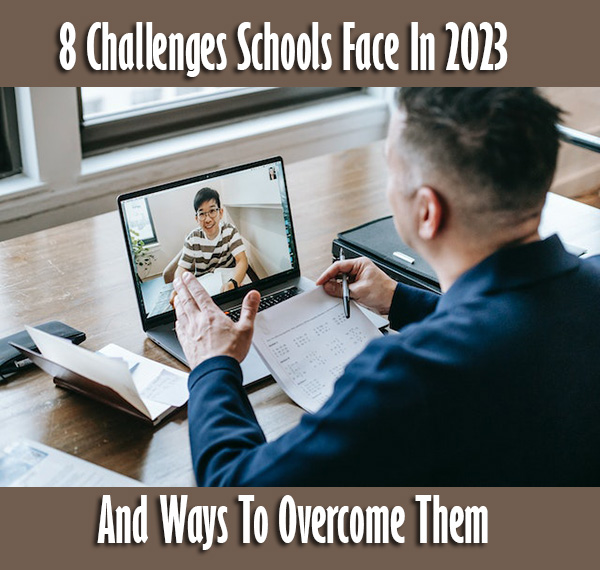Education is an essential pillar of any society, shaping the future of individuals and nations. Schools are critical in providing students with the knowledge and skills they need to succeed.
However, schools face many challenges that can hinder their ability to provide quality education to all students. As we move forward into 2023, these challenges are becoming more significant than ever.
From addressing mental and emotional needs to adopting new technologies, the challenges are complex and multifaceted. This requires innovative solutions that go beyond traditional approaches to education.
By implementing strategies such as providing professional development opportunities to teachers, incorporating technology, promoting student-centered teaching approaches, and community involvement, schools can create a personalized and equitable learning experience for all.
With that said, let’s discuss the profound challenges schools face and how to overcome them.
Embracing Technology
The rapid pace of technological advancements has revolutionized how we learn and teach, but not all schools have the resources or the knowledge to adapt to these changes. Integrating technology effectively into lesson plans and curricula and ensuring student access to technology and internet connectivity remains challenging for many schools.
To address this challenge, schools can offer ongoing professional development opportunities to teachers. This way, teachers can learn about the latest digital tools and how to integrate them into their teaching. This may include training sessions, workshops, and online courses.
For aspiring educational leaders, online degrees in education can be an excellent option. These programs include courses on technology integration, instructional design, personalized learning, and student-centered teaching approaches.
Additionally, the online format of these programs can make it easier for teachers to balance their professional and personal commitments while pursuing their degrees.
Beyond professional development, schools can also leverage modern technology to streamline everyday operations. For instance, ai chatbots for schools often offer a practical solution. These chatbots can provide instant answers to frequently asked questions, automate routine administrative tasks, and facilitate communication between teachers, students, and parents. By adopting such tools, institutions can enhance efficiency and free up staff time to focus on teaching and student engagement.
Assessment Strategies
Despite the shift towards MCQ-based or objective exams, subjective assessments continue to lead to inconsistent grading and a need for more transparency in the assessment criteria.
To overcome this challenge, schools can:
- Adopt a more comprehensive approach to assessments, including formative assessments, self-assessments, and peer assessments.
- Develop a clear assessment criterion so students know what is expected of them.
- Leverage technology to create more objective and reliable assessments, such as automated grading software or online assessments that provide immediate feedback.
- Train teachers on assessment strategies and how to identify and mitigate bias in their grading practices.
Virtual Classroom Engagement
As online classes become the new normal in the education sector, it can be challenging to gauge student engagement due to a high student-to-teacher ratio, limited class time, and a lack of proper monitoring metrics.
Schools can adopt several strategies to engage students in virtual classrooms, such as:
- Create interactive learning experiences that involve students actively in the learning process, such as through online polls, quizzes, and group activities.
- Use multimedia resources such as videos, animations, and graphics to enhance student engagement.
- Leverage technology to monitor student engagement using analytics tools that track attendance, participation, and performance.
- Provide training and support to teachers on effective virtual classroom management and engagement strategies.
Chronic Staffing Shortages
Chronic staffing shortages are a significant challenge many schools face, particularly in high-demand subject areas. This can lead to larger class sizes, reduced course offerings, and increased workload for existing teachers, impacting the quality of education students receive.
To overcome this challenge, schools can:
- Provide competitive compensation and benefits packages to secure and retain highly qualified teachers.
- Establish partnerships with local colleges and universities to develop pipelines for new teachers entering the profession.
- Explore alternative staffing models, such as online or blended learning.
- Work with policymakers and community stakeholders to address broader teacher recruitment and retention issues.
Issues of Equity and Access
Students from marginalized communities, such as low-income families and racial and ethnic minorities, often face significant educational barriers. These barriers include limited resource access, inadequate funding, and inadequate support systems.
To promote equitable access to education, schools, and educational leaders should increase funding for low-income areas, create programs that help students overcome barriers, and promote diversity and inclusivity in classrooms.
Mental and Emotional Health
The outbreak of COVID-19 has highlighted the importance of schools in addressing their students’ mental health and emotional needs. Many students have been facing anxiety, depression, and social isolation due to the disruptions in their lives.
One solution to this challenge is to implement mental health programs in schools. These programs can include counseling services, mental health resources, and support groups. Teachers and staff can also receive training to effectively recognize and respond to students’ mental health needs.
Changing Job Market
In today’s fast-paced world, where technological advancements and global economic changes occur at an unprecedented rate, preparing students for the constantly evolving job market is a significant challenge for schools. Schools must prioritize the development of critical thinking, problem-solving, and digital literacy skills to ensure students are equipped to succeed in the modern job market.
Schools can incorporate technology and new teaching methodologies, such as project-based and blended learning, to foster these essential skills. Additionally, schools can partner with industry leaders and organizations to provide students with internship opportunities and mentorship programs that expose them to the real-world applications of their learning.
Addressing Special Needs
According to the NCES, more than 7 million students in the US receive special education services. Students with special needs require specialized instruction, accommodations, and assistive technology to succeed in school. However, many schools may not have the resources or support to meet these needs adequately.
One solution is to provide professional development for teachers on how to teach students with disabilities or special needs effectively. This can include training on strategies for differentiated instruction, classroom accommodations, and assistive technology. Additionally, schools can allocate funding for additional resources, such as specialized equipment and therapists, to support these students.
Inclusive education is also an effective solution. It integrates students with disabilities into regular classrooms, promoting social inclusion and fostering social skills and self-confidence.
Conclusion
As the education sector evolves, schools must remain flexible and open to change by embracing new technologies and teaching approaches. Additionally, schools must prioritize collaboration and communication among stakeholders, including teachers, students, parents, and administrators.
By working together and implementing innovative solutions, schools can create a learning environment that prepares students for success in a rapidly changing world.
By committing to continuous improvement and focusing on meeting the needs of all learners, schools can combat the challenges of 2023 and beyond!







Speak Your Mind